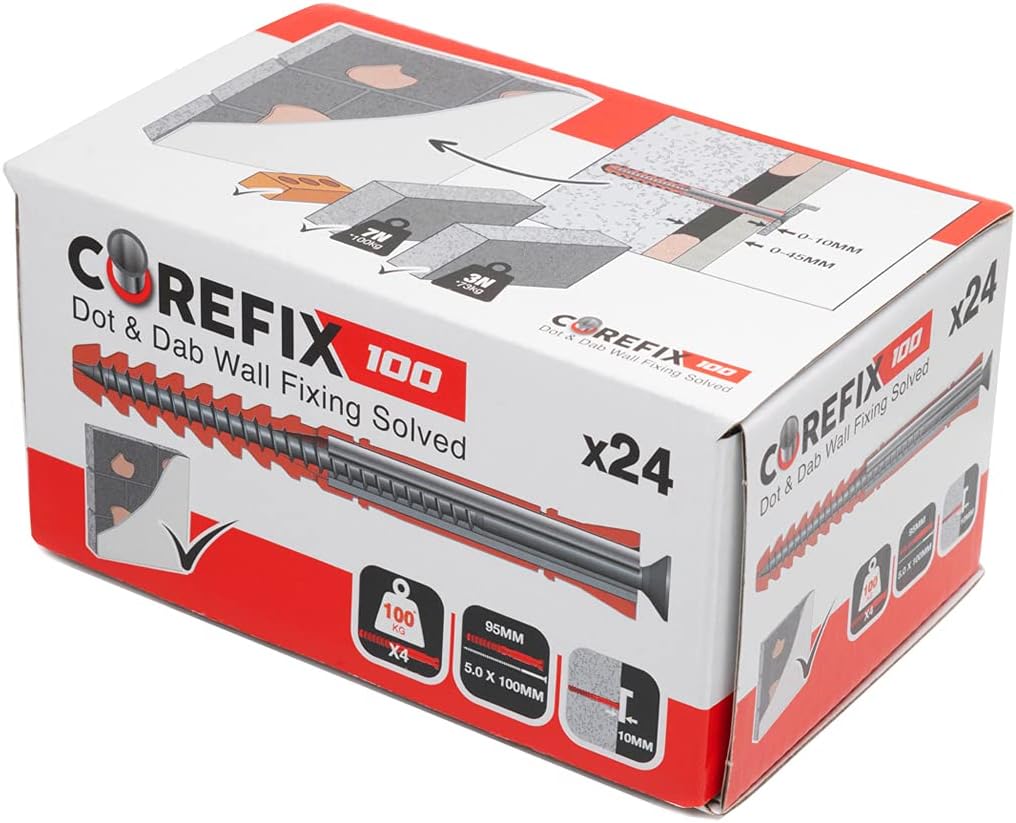About this deal
buy some metal studs or make them by cutting down threaded rod and adding nuts and washers. 6mm or 8mm diameter rod will be fine for hanging a plasma screen as long as the wall is sound and you fix with 6 points. Dot and dab is used where there is no stud wall to screw (or nail) the plasterboard to. If dot and dab isn’t suitable for your project, then stud work may be a better option. This technique involves attaching the plasterboard to metal studs or timber studs that have been placed at regular intervals along the wall. This provides a more secure fixing than dot and dab and is often used in areas where there is a higher risk of the boards delaminating from the wall due to an uneven surface. While dot and dab is effective on walls it isn’t a good choice for ceilings. The adhesive doesn’t have enough strength to keep it secure, which means it could fall down. Use offcuts of plasterboard to keep the plasterboard off the floor (Image credit: British Gypsum) Is Dot And Dab Better Than Plastering?
Dot and Dab Plasterboard: A How-To Guide for Smooth Walls Dot and Dab Plasterboard: A How-To Guide for Smooth Walls
Follow our step-by-step guide to find out how to prep your walls, mix the adhesive and measure up for the perfect finish. Dot and Dab Plasterboard: The Tools You’ll Need For the Job For dot n dab you need something that will anchor in to the solid wall behind and provide a stand-off to take the weight/pressure away from the plasterboard surface. There's a couple of products that fit the bill: Installing insulated plasterboard is a simple process and requires no specialist methods. Simply raise the board and hold it against the wall, ensuring all edges are straight and level. Once you have applied the adhesive, press the plasterboard onto the wall and hold it firmly until you are sure it is attached. If you have any concerns about the plasterboard being straight and level, a featherhead tool can be used to ensure a smooth surface, as its edges are straight by design. Dot & Dab Equipment Essentials: If you have to make a cut for a window or door, measure how far the edges are from the last whole board and mark on the plasterboard with a pencil. Now lie the board on the floor and use a straight edge, i.e. a spirit level, and use a Stanley knife to make the cuts. As the name would suggest, a dot and dab wall, otherwise known as a drylined wall, involves making small ‘dabs’ of plasterboard adhesive across a wall surface and then pressing it into place. This technique is often used when the surface to which the plasterboard is being fixed is uneven, as it helps to create a smooth, level surface without using wet plaster. Since you are avoiding the faff of wet plastering, you can also paint your application in record time – as you cut out applying and drying times. When is it Appropriate to Dot and Dab Plasterboard?
Dot and dabbing plasterboard is a prelude to skimming or plastering walls so you need to get it right. Get it wrong and the plasterboard could pull away from the wall under the weight of the plaster. And nobody wants to see their beautifully painted wall suddenly heading towards them when they are comfortably sitting watching TV. When dot and dabbing, it’s important to use an appropriate plasterboard adhesive. A good quality dot and dab adhesive will help to keep the board in place and prevent it from falling off. For this reason, plasterboard adhesive is also known as bonding compound. How To Dot & Dab Insulated Plasterboard
How to fix tv bracket on dot and dab wall | DIYnot Forums How to fix tv bracket on dot and dab wall | DIYnot Forums
Minimal thermal bridging due to the use of non-metallic gypsum adhesive dabs and thermally-broken fixings.If your wall is made of wood or metal studs, then you should use a different technique such as screwing or nailing the boards into place Both dot and dab and wet plastering have their merits. On the whole, dot and dab method has a bevy of advantages over traditional wet plastering:
Fixings - The Ultimate Heavy Duty Plasterboard Fixing Bullfix Fixings - The Ultimate Heavy Duty Plasterboard Fixing
The adhesive helps repair existing walls, providing a level surface for a better finish when plastering or decorating. set up your resin anchor in a mastic gun and ensure you have the studs to hand. Get a cloth for cleaning excess resin. You can use masking tape to protect the wall finish and also use it to make a support sling if you find the studs drooping after being insertedbuy a suitable drill bit approx 4mm bigger than the diameter of the studs being used. i.e. 6mm stud = 10mm drill bit Get a couple of offcuts of plasterboard and place them on the floor. These will keep the plasterboard off the floor and leave a small gap. Position the plasterboard on the offcuts and press firmly against the wall. read the setting time in the instructions for your resin compound. Take note of the room temperature Allows Gyproc ThermaLine laminates to be installed to existing plastered surfaces providing they are sound and free of damp.
 Great Deal
Great Deal 